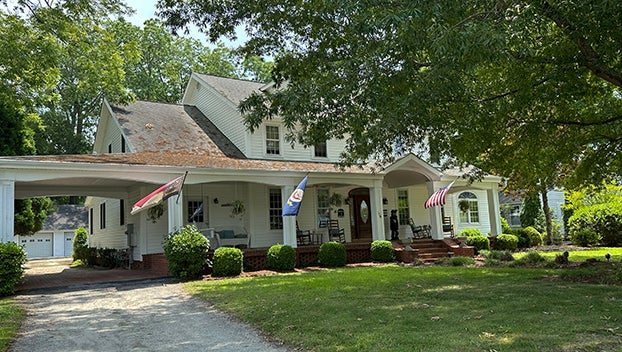Be on the lookout for insects and pests
Published 11:50 am Thursday, March 25, 2021
|
Getting your Trinity Audio player ready...
|
There are several insect and disease pests to be on the lookout for this time of year. I’ll start by mentioning the Plant Disease and Insect Clinic (PDIC) on the campus of NC State University. Their lab is an amazing resource that will help diagnose pest and disease problems on all types of plants. However, if you are having a pest or disease issue, it is best to begin the diagnostic process with your local extension agent or Extension Master Gardener Volunteer (EMGV). There are many problems that can be diagnosed without going to the clinic. If it is necessary to use the clinic, they provide a free diagnostic service using images and background information only. This works in many cases but if they require a physical sample, it is still best to go through your local agent because they give a $10 discount off the regular $30 cost of diagnosis. EMGV’s are a great resource, available in most counties throughout NC, that can help with general horticulture knowledge and specialized care of plants as well as plant disease and pest diagnosis. Before they can provide this service, EMGV’s must obtain their EMGV Certification through attending 40 hours of classroom instruction and a 40-hour internship. There will be a class held in Beaufort County this fall. If you are interested, please fill out an application available at the office located in Washington at 155 Airport Road.
Another great service PDIC provides is the ongoing, advanced education webinar series, Plants, Pests, & Pathogens, for EMGV’s and extension agents. The recordings can be found by visiting go.ncsu.edu/ppp. The webinar provides practical information and a presentation from a guest speaker. The most recent webinar had Insect and Disease BOLO’s (be on the lookout for) from NCSU Entomologist Matt Bertone and NCSU Pathologist Mike Munster.
According to Matt Bertone, home gardeners should be on the lookout for foliage feeders beginning to feed on leaves, white grubs in the soil, and scale insects are mating. Foliage feeders are not generally an issue in residential properties. White grubs feed on roots of turf and other plants, then pupate into June beetles, Green beetles, Japanese beetles, and so on. White grubs are also what moles are foraging for throughout the winter. Typically, we would peel back a square foot of turf and count the number of white grubs found just under the turf roots in several places throughout the lawn. If more than 5-6 per square foot are found, it is time to treat for white grubs. There are several products that can be purchased from local hardware and garden stores to treat. Timing is important, treat in late-April to mid-May and again in September. Scale insects are most susceptible to treatment during the crawler stage which begins in early to mid-May. The least invasive product to use is a type of summer horticultural oil. This will be much less harmful to beneficial insects and pollinators than insecticides. In addition to these, cockroaches, slugs, spiders and such will be more active around the house right now.
In our ornamental plants we should be looking for spot anthracnose on dogwoods right now as they are beginning to bloom. Entomosporium leaf spot will be very visible on susceptible varieties of photinia and Indian hawthorn. This shows up as a dark red leaf spot. Control is possible but difficult, the recommendation is to replace the plant with a resistant variety. Cedar-apple rust and cedar quince rust will be showing up on Bradford Pears and Apple trees within the next month. This will cause deformed fruit and branch dieback in many cases.
In our vegetables we should be looking for Pythium root rot and damping off. This will show as a general collapse of the stems in young plants. Now is the time to be looking for peach leaf curl and brown rot on peach blossoms and twigs. Pears and apples will show signs of fire blight infection. Look for the characteristic shepherd’s crook on the branch ends then follow the branch to find the canker. Fire blight is a bacterial disease that makes pears and apples quite difficult to grow in our area. Left unchecked, it will eventually gum up the vascular tissue of the tree causing the tree to die. You can prune fire blight out of the tree by going 10-12 inches below the canker. Make sure to sterilize your pruning shears in a 10% bleach-water solution after every cut.
As our grasses begin to green-up, look for fairy ring, spring dead spot, and large patch. Fairy ring presents as a ring of mushrooms, or a dark or light-colored ring of turf. There is not a control available to the homeowner for this disease. Spring dead spot is most often found in Bermuda grass. It is the result of a disease that weakens the turf causing it to be more susceptible to winter damage/kill. There are cultural controls and fungicides that are recommended for this disease available through the extension office. Large patch is most often found in centipede and St. Augustine grasses. It presents in the spring as a circular dead spot in the turf. The disease, although most notably seen in the spring, is most open to treatment in the fall when soil temperatures begin to decline. More information is available through the extension office on all of these diseases.
The Extension Master Gardener Volunteers have a great project right now. They are putting together a Lunch and Learn series on How to Grow a Salad in a Bucket. The series began Thursday, March 25 at 12:00 p.m. You can register for the remainder of this series by visiting go.ncsu.edu/saladinabucket. There will be six sessions on the subsequent Thursdays at noon. Over the course of our thirty minutes together on zoom, we will go through the how to’s of growing your own salad in a series of five-gallon buckets. The program should take 15-20 minutes leaving 10-15 minutes for questions.
Mark your calendar, the EMGV’s will be having a vegetable sale coming up in April. Plants have been propagated by the EMGV’s to raise money for the new Teaching Garden at the Beaufort County Extension Center. There are over 500 plants for sale including several varieties of tomatoes and peppers. I will have more information on the sale in the coming weeks so stay tuned to my weekend articles.
Have horticulture a question, call the Extension Master Gardener Volunteers in Beaufort County or Gene Fox, the Area Consumer Horticulture agent at (252)946-0111 or please email Gene at gene_fox@ncsu.edu. Your question might just make the paper.
Gene Fox is the area consumer horticulture agent with North Carolina Cooperative Extension.





